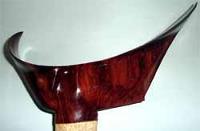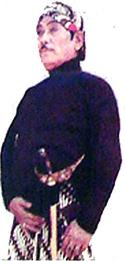|
Anda Agung is a pamor Rekan. It consists of straight lines, which are joined up as an inverted V. It begins at the Sor-Soran and extends to the tip of the blade. It looks like pamor Ujung Gunung, the difference is that it convey a more convex impression. The magical power assists the owner in the career and the acquis. It is very popular because it does not belong to the selected pamor motives and anyone can possess. It also belongs to pamor Miring. Read more here.
|
|
A |
|
Andoran sometimes also called a kind of thing to wear the keris. One finds this in Java in Surakarta and surrounding area. Here, as the Sabuk Londong (loincloth) of fabric and the Keris is supported between the second and third wrapping. The sheath is sitting in the middle of the back so that you can pull the keris with his left hand. This support means is selected if you want to give respect, so the ruler (in the palace) or in the mosque. These carrying method can not be applied in a sitting position of course, only in an upright position and only very tall people in a sitting position, . This attitude is called in other areas also Dedaran or Jejaran.
|

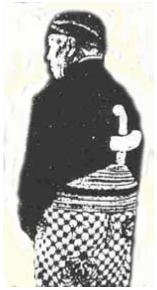
|
Angaggar this type to wear the keris can be found in Central Java, so in Surakarta and Yogyakarta. This is not clamped as Andoran between Sabuk Londong but kept in a special place. It is in a belt, Epek called hooked. These carrying method is only found for soldiers of the palace, where in most cases only the commander in military events or during the war. Of course, the king allowed to wear the keris as, for normal people this is prohibited. Except for the carrying methods are Kewal and ogleng.
|
|
Anggabah Kopong is one of four species of a blade tip of a keris or Tombak. This blade tip has been used in almost all krisses from the Tangguh Pajajaran and even in old Tuban - krisses. Krisses with these tips are especially good for religious and spiritually interested people.
|

|
Angga was a well-known Empu in Pajajaran in the 11th century. His krisses were luxuries (straight Keris) without Kembang Kacang and Sogokan. The pamor was very fine. He also used the name Empu Singkir and is related to the Empu Kuwung, Empu Keleng and Ni Mbok Sombro.
|
|
Angga Curwiri was a well-known Empu in the era of Majapahit in the 13th century. His krisses had a very long ganja. His krisses were not wide but thick.
|
|
Anggodong Pohung is a part of the blade of a relatively thin straight keris without Ada-Ada. The shape is also called Mbambang or Nilam Upih. There are many krisses with this blade in Dapur Tilam Upih.
|

|
Anggrek Kamarogan, Kinatah Anggrek means orchid and this can be found on the surface area of a keris, Tombak or Pedang. It is deorated with silver, gold (kinatah) or gold. It is normally called Kamarogan Silih Asih. Kinatah Anggrek Kamarogan normally covers the entire surface of the blade. In earlier centuries, only kings had this kind of Keris.
|
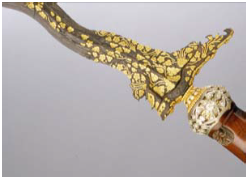
|
Anggup Anggup is a part of a Warangka Branggah or Ladrang. The Anggup is very thin and unfortunately can break very easily.
Anggup Warangka Ladrang Solo
|

|
Anggup Randu is a mendak model from Surakarta. This mendak is normally without stones.
|

|
Anjani, Kyai oder Ki was a well-know Empu in the age Pajajaran (11th century). His krisses were thin and long. In some literature is to read this Empu was a woman, but it is more likely that it was a man. The pamors were good and had mostly pamor Udan Mas, Wos Wutah or Pedaringan Kebak as a motive. The ganja was also thin and Ganja Wuwung. His krisses had to keep getting positive magical powers in the coexistence with neighbors and above disorders and diseases. In the old keris books this Empu is also called Empu Dewanjani. |
|
Anoman is a Dapur, mentioned in ancient books also Hanuman. Hanuman is a good figure from the Ramayana story. It is a rare Keris Luk 5. It has a Kembang Kacang, Lambe Gajah, Ri Pandan and the Sogokan goes from the Sor-Soran to the tip of the blade. The Ganja has Greneng. One recognizes this Dapur quickly because the Sogokan is so long. In Brunei and Malaysia the Keris is also called Keris Alimai. |
|
Antup-Antupan is a part at the top of gandar. Warangkas for a pendok have normally a small hole at the top of gandar in the center and about 2 - 3 millimeters deep. This is to allow the ventilation so the gandar do not rot and the Keris attaches no rust. On the island of Riau, in West Borneo and parts of Malaysia Antupan-Antupan gandar are also called Batang bunts. |

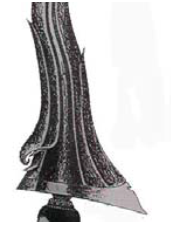

|
Aren is a type of wood that is used only for Tombak. It is strong and heavy. |
|
Areng is a type of wood called Ebony - see Eboni. |
|
Aring Keris is a part of the keris for a Ganja. These are available in Malaysia, parts of Riau, on the island of Sulu and Brunei. Often you will also find a Greneng. |
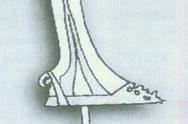
|
Arjanati, Kanjeng Kyai is a Tombak from Pusaka Puro Pakualaman, Yogyakarta. The shape is very unusual and is therefore called kalawijan. The blade is straight ahead. |

|
Arsenikum or shortly AS is known to us as part of the arsenic and Warangan for cleaning the keris. |
|
Aruk-Aruk are Tombak of the people of Aceh in Sumatra Gayo in Northern parts. This Tombak can be used for boar hunting. The tip is usually circular / round and the length of the Tombak is more than 80 inches (2 meters). |
|
Asanmunawi is a well-known Empu from Yogyakarta, also well known is his helper Empu Supowinangun, both from Yogyakarta. From 1925 on they produced krisses for 10 guilders. They sold the handles expensive because they had to go shopping in Yogyakarta or Surakarta the pamor material was expensive. The works were good enough but as demand subsided they ceased their work. |
|
Asem is a timber for the manufacture of a Keris handle. Earlier this wood was often used for a Keris from Cirebon. Now it is often used for the production of a Golok. This wood is strong and hard. The color is dark red to brown. Asem wood is used for a Warangka. |
|
Asihan is a pamor appearing on the Ganja. This name is also used as an additive for other pamor motives. So then called the pamor Ngulit Semangka also Ngulit Semangka Asihan when extending the original pamor using the Ganja. |

|
Asmaranda is a part of a handle made of wood. This gave the citizens in the earlier centuries women and domestic workers, thus also simple people sought this type of grip. |


